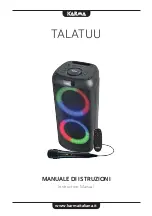
- 7 -
When in the MMA mode, use to insert the Voltage Reduction Device “VRD” .
7b INITIAL CURRENT (I
START
)
I
s
[A]
When in the TIG 2 stroke and SPOT modes it represents the initial current
I
S
that is maintained for a fixed time with the torch push-button pressed
(adjustment in Amperes).
When in the TIG 4 stroke mode, it represents the initial current I
S
that is
maintained for the whole time during which the torch push-button is pressed
(adjustment in Amperes).
When in the MMA mode, it represents the “HOT START” dynamic overcurrent
(adjustment 0 ÷ 100%). With indication on the display of the percentage
increase as to the pre-selected welding current value. This adjustment
improves welding fluidity.
7c INITIAL SLOPE (t
START
)
t
s
[sec]
When in the TIG mode this is the initial slope time of the current (from I
S
to I
2
)
(adjustment 0.1 ÷ 10 s). When at OFF there is no ramp.
The I
START
and t
START
parameters can be used even with remote commands
given from the pedal, but the adjustment must be made before activating the
command.
7d MAIN CURRENT (I
2
)
I
2
[A]
In the TIG AC/DC or in the MMA mode, I
2
is the output current; in the PULSED
and BI-LEVEL mode I
2
is the maximum current. The parameter is measured
in Amperes.
7e BASE CURRENT - ARC FORCE
I
1
[A]
When in the TIG 4 stroke, Bi-LEVEL and PULSED mode, I
1
is the current
value that can be alternated with the main one, I
2
, during welding. The value
is measured in Amperes.
When in the MMA mode, this is the dynamic “ARC-FORCE” overcurrent
(adjustment 0 ÷ 100%); the display shows the percentage increase as to the
value of the pre-selected welding current. This adjustment improves welding
fluidity and stops the electrode from sticking to the workpiece.
7f FREQUENCY
Hz
This is the pulse frequency when in the TIG PULSED mode. For AC/DC
models in the TIG AC mode (with pulsing disabled), it is the frequency of the
welding current.
7g BALANCE
BAL
( AC/DC model )
( DC model )
BAL
When in the TIG PULSED mode, this is the ratio (as a percentage) between
the time during which the current is at its highest level (main welding current)
and the total pulse period. In addition, when the AC/DC models are in the
TIG AC mode (with pulsation disabled), the parameter represents a ratio
between the time with positive current and the time with negative current: if
the parameter value is negative heating and workpiece penetration increase,
if the parameter value is positive surface cleaning is greater and electrode
heat increases, while if the parameter value is null there is balance between
the negative and positive currents during the AC frequency period.
(TAB. 4)
.
7h SPOT TIME
When in the TIG (SPOT) mode it represents the welding duration (adjustment
0.1 ÷ 10 s).
7k END SLOPE (t
END)
t
e
[sec]
When in the TIG mode it represents the end slope time of the current (from I
S
to I
2
) (adjustment 0.1 ÷ 10 s). When at OFF there is no ramp.
7l END CURRENT (I
END)
I
e
[A]
When in the TIG 2 stroke mode it represents the end current I
e
but only if the
END RAMP (7k) has been set at a value higher than zero (> 0.1 s).
When in the TIG 4 stroke mode it represents the end current I
e
for the whole
time during which the torch push-button is pressed.
The sizes are expressed in Amperes.
7m POSTGAS
[sec]
When in the TIG mode, it represents the POSTGAS time in seconds
(adjustment 0.1 - 10 s), and protects electrodes and pool welding from
oxidation.
7n ELECTRODE PREHEATING
[A
•
sec]
When in the TIG AC mode, this adjusts electrode preheating to make welding
starting easier (adjustment 2.6 ÷ 53 A·sec.). The higher the value set, the
higher the preheating energy. When at OFF there is no preheating.
8- REMOTE CONTROL LED. Used to transfer control of the welding parameters to
the remote control.
9- Parameter setting (7) encoder knob and parameter selection key (7).
10- Alphanumeric display.
11- Green LED, power on.
12- ALARM signalling LED (the machine has stopped).
Resetting is automatic when the reason for alarm activation stops.
Alarm messages shown on the display (10):
-
“
AL.2
”
:
general protection has cut in (thermal or network overvoltage or
undervoltage).
-
“
AL.9
”
:
protection has cut in because of insufficient pressure in the water
cooling system of the torch. Resetting is not automatic.
When the welding machine is switched off, the signal “
AL.2
” may appear for a few
seconds.
5. INSTALLATION
WARNING! CARRY OUT ALL INSTALLATION OPERATIONS AND
ELECTRICAL CONNECTIONS WITH THE WELDING MACHINE COMPLETELY
SWITCHED OFF AND DISCONNECTED FROM THE POWER SUPPLY OUTLET.
THE ELECTRICAL CONNECTIONS MUST BE MADE ONLY AND EXCLUSIVELY
BY AUTHORISED OR QUALIFIED PERSONNEL.
5.1 PREPARATION
Unpack the welding machine, assemble the separate parts contained in the package.
5.1.1 Assembling the return cable-clamp (FIG. E)
5.1.2 Assembling the welding cable-electrode holder clamp (FIG. E)
5.2 POSITION OF THE WELDING MACHINE
Choose the place to install the welding machine so that the cooling air inlets and
outlets are not obstructed (forced circulation by fan, if present); at the same time make
sure that conductive dusts, corrosive vapours, humidity etc. will not be sucked into
the machine.
Leave at least 250mm free space around the welding machine.
WARNING! Position the welding machine on a flat surface with
sufficient carrying capacity for its weight, to prevent it from tipping or moving
hazardously.
5.3 CONNECTION TO THE MAIN POWER SUPPLY
- Before making any electrical connection, make sure the rating data of the welding
machine correspond to the mains voltage and frequency available at the place of
installation.
- The welding machine should only be connected to a power supply system with the
neutral conductor connected to earth.
- To ensure protection against indirect contact use residual current devices of the
following types:
- Type A (
) for single phase machines;
- Type B (
) for 3-phase machines.
- In order to satisfy the requirements of the EN 61000-3-11 (Flicker) standard we
recommend connecting the welding machine to the interface points of the main
power supply that have an impedance of less than Zmax = 0.283 ohm.
- The IEC/EN 61000-3-12 Standard does not apply to the welding machine.
If the welding machine is connected to an electrical grid, the installer or user must
make sure that the machine can indeed be connected (if necessary, consult the
company that manages the electrical grid).
5.3.1 Plug and outlet
Connect a normalised plug (2P + P.E) (1~); (3P + P.E) (3~) - having sufficient capacity-
to the power cable and prepare a mains outlet fitted with fuses or an automatic circuit-
breaker; the special earth terminal should be connected to the earth conductor (yellow-
green) of the power supply line. Table
(TAB.1)
shows the recommended delayed fuse
sizes in amps, chosen according to the max. nominal current supplied by the welding
machine, and the nominal voltage of the main power supply.
WARNING! Failure to observe the above rules will make the (Class 1)
safety system installed by the manufacturer ineffective with consequent serious








































